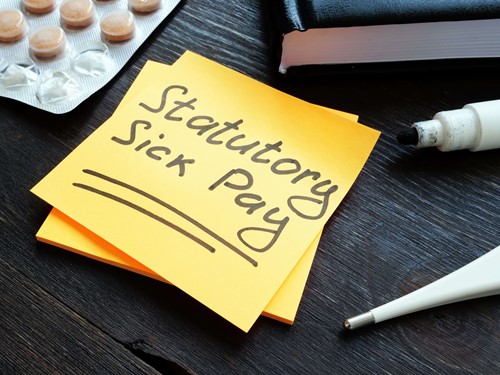Managing sickness absence across your workforce is a difficult and time-consuming task. It's also an inevitability in the modern business world—and a major part of employment law.
So, you should prepare for staff taking statutory sick leave in the UK and provide employees with a thorough and fair process. You should also inform your staff members what this is.
And in this guide, we'll guide you through the different areas that should be covered in your sickness absence policy.
If you need support in creating a sickness absence policy, get in touch with one of our HR experts on 0145 585 8132.

Sick leave entitlement
In the UK, it's a staff member's right to take sick leave if they're ill. There isn't legislation that permits the taking of sick leave, but the right to SSP is covered in the Social Security Contributions and Benefits Act 1992 as amended (SSCBA 1992) and the Statutory Sick Pay (General) Regulations 1982 (SI 1982/894).
Statutory sick pay (SSP)
Employees qualify for SSP on working days, weekend work for full-time employees and their normal working days for part-time employees. SSP payments are made subject to tax and national insurance deductions. Employees who are not eligible for SSP will take that period of sickness as unpaid. No variable payments such as commission or bonuses may be paid and no basic pay shall be made unless there is a contract requirement to do so.
SSP is paid when the employee is sick for at least four days in a row, including non-working days and public holidays. As the employer, you are responsible for paying SSP however, you don't get any sick pay for the first three days you are sick.
Your organisation does not need to pay SSP for the first three days of any sick leave period (these are classed as “waiting days”). Sometimes your business may also need to pay the first three days if it's a linked period (regular periods of illness).
The paid statutory sick pay for this is £109.40 per week. Companies can also set different sick pay schemes, but the amount cannot be less than the SSP.
How long can my employees claim sick leave?
Well, staff can claim up to 28 weeks' worth a year if they call in sick for seven calendar days. The sick leave reasons are many and varied. It could be due to:
- An accident or injury.
- Sudden illnesses (such as the flu)
- Long-term illnesses.
Can I ask for a reason my employees need sick leave?
Yes. Staff must provide you with proof of their sickness—But from the first 1-7 days employees can self-certify, after that they need a fit note.
To do this, they can provide you with a fit note (“sick note”). Staff can obtain this from the nurses, occupational therapists, pharmacists, and physiotherapists have been able to sign fit notes, alongside doctors. To do this, they must be working in a general practice or hospital setting. This means they must be based either in-house at a GP surgery or working within a hospital; those working in chemists or private businesses cannot sign these.
They're free to get it if the employee is off ill for eight days or more.
You may also wonder, “Is it illegal to work while on sick leave?”
Notification of sickness
If employees are unable to attend work due to sickness absence, they must notify their line manager by phone on the first day of the sickness absence.
They will need to explain why they are unable to attend and indicate a later date when they intend to return to work. They should also keep their employer updated each day until they get a fit note or return.
Certification
If the employee is absent for seven calendar days or less in each instance, the employee may self-certify their absence. For absences of eight days or more, self-certification or a fit note of attendance is required.
The doctor's note should cover each day of absence and, if multiple fit notes are issued, they should be posted to the employee’s line manager with a brief explanation of their absence, the condition and, if known, their expected return to work date or next GP appointment.
Failure to follow the certification process outlined above may be considered misconduct and may be dealt with under the Company’s disciplinary process.

Return to work after a sickness absence
A fit note may make a recommendation for temporary changes to be made to an employee’s working environment or conditions to facilitate a return to work.
Where the fit note contains recommendations for changes to be made to working conditions or practices, the Company will consider those recommendations and try as far as possible to accommodate those changes, where permissible in accordance with the needs of the business.
If the company believes the medical evidence and that further advice or a medical opinion on occupational health is necessary, the company reserves the right to require an employee to be referred to a medical practitioner for an occupational health assessment to be undertaken.
Access to medical reports
The Company may need to request a copy of an employee’s medical reports or medical records to assist in the assessment of the employee's medical condition.
The employee’s consent, in line with requirements under the Access to Medical Reports Act 1988, will be obtained prior to the Company making contact with their GP.
Long-term sickness absence policy
The definition of long-term sickness absence policy differs from company to company. There are, however, three main interpretations:
- Consecutive sickness absence for eight days or longer.
- Absent from work for more than four weeks.
- A serious illness may also involve an operation or significant recovery time. This could be a significant mental health issue, not just a physical one.
These definitions at the very least provide a minimum to work with—eight days.
With this in mind, you should define your business’s view on long-term sickness absence in your company policy.
Dealing with long-term sickness absence
If one of your employees is on sick leave and you aren’t sure how to manage the situation, there are some steps you can take:
Hold a formal absence meeting
Normally, you would hold this after over 4 weeks of absence where there are no plans for an imminent return.
Be as flexible with this meeting as you can. If you can conduct the meeting via video call, do so. Make sure they’re aware a family member can accompany them.
The purpose of this meeting should be:
- To understand the condition of the employee.
- Discuss what adjustments you can make to help them back into the workplace.
Take substantial notes
The meeting is formal, which means you should be taking notes of what you discuss. Not only does a good practice of this help manage the rest of the process, but it also proves that you are following a fair process.

Follow up in writing
Make a copy of the meeting notes and send a copy to the employee. You should also write to them regarding any adjustments you’re making to encourage them to return to work meetings.
Record the impact of long-term sick leave
The “impact” is often financial, but it’s important to look beyond that. What is the impact on their colleagues? Are they picking up extra work as a result of the absence? Document all of this and keep a record.
Consult with occupational health professionals. You can write the rules relating to your employee's occupational health, to gain consent to gather further medical information from their GP.
This will help you assess how long the absence could last and what adjustments you can make. The employee has the right to see their GP’s notes before you receive them.
Hold a second absence meeting
If the employee is off work for a further month, you can consider a second meeting. Follow the same format as your first meeting. Refer back to all of the information you gathered in the previous steps and discuss them. Review any steps already taken and judge their effectiveness.
Hold a final meeting
If the employee continues to be absent from work and there is no medical report and no clear return to work date or the medical reports show there is no reasonable prospect of return. You can invite the employee to a final meeting.
If they still can’t return to work, you may pursue a formal action for capability dismissal. Throughout this whole process, remember that employees have long-term sick leave entitlements, such as statutory sick pay (SSP).
Long-term sick pay
Most employees are entitled to up to 28 weeks of SSP. The current rate for this long-term sick pay is £109.40 a week. To be eligible for this they must hit certain criteria, such as:
- They must be an employee or worker and currently working for you
- They must earn a minimum of £123 per week
- They must abide by your company's absence rules, particularly when notifying you of absence
After the 28 weeks are up, they can apply for employment and support allowance (ESA).
Those on long-term sick leave can carry their annual leave into the next holiday year. They don’t have to request it. You should pay them for this outstanding leave if you terminate their employment.
Can an employer dismiss an employee on long-term sick leave?
Yes, you can dismiss an employee on long-term sick leave, but only after following a reasonable process.
If your employee has more than two years’ service and/or their absence is due to a disability, you are at risk of an unfair dismissal and discrimination claim. Before considering dismissal, you should be holding a series of meetings and obtain medical information to guide your decision-making.
Return to work after long-term sickness absence
The longer an employee’s absence is, the more difficult getting back to work after long-term sickness or absence can be. You have a number of options to try and make the transition easier.
The first is a phased return to work. With this approach, you can reduce working hours, working days, and even working weeks. You should discuss this with the employee before returning them to work to find a balance they’re comfortable with.
On the first day back, you should hold a return to work meeting. This will help assess how the employee is feeling about the return, and whether they have any lingering concerns. It may be worth having another catch-up a week or so later to see how they are getting on.
The goal is to reduce the absence levels and the anxiety the individual may feel upon their return. This is particularly important if the reason for their absence was due to their mental ill health.
Long-term sickness absence policy
The key to ensuring employee absence is effectively managed is to create a solid sickness absence policy. Chances are, you already have one of these. However, it’s never a bad time to review, particularly to ask the question: “Does this cover all long-term sickness absence and short-term sickness absence employment rights in the UK?”
Here are the key things to consider when assessing (or creating) your own, long term absence full-term, sickness absence policy, or short-term sickness absence policy:
- What is its purpose and scope: The policy should cover what classes as long-term sickness absences. It should also make clear that capability dismissal is a possibility. Finally, it should highlight that you need to balance the disruption to company productivity and the time for the employee to recover.
- What do you expect of employees and managers: Highlight the importance of communication between employees and their line managers. Mention that you will require medical evidence in the form of a fit note for absences longer than seven days.
- Does the employee know their entitlements: Make staff aware of their sick pay entitlement. If you offer enhanced sick pay, highlight this too. Staff will also continue to accrue holiday as normal during sick leave. They can carry this leave over into the new holiday year. If the employee faces a capability dismissal, make sure they know they can appeal this decision.
- When do meetings occur: Set trigger points for when you intend to hold meetings. For example, state that you will schedule a meeting after 28 days of absence. Set another after 3 months of absence, and so on.
- What can you do to accommodate a return to work: There are many ways you can help an employee return to work after a period of absence. Highlight these methods:
- A phased return to work
- Back to work meetings
- A temporary role reassignment
- Do you take special cases into account: Certain circumstances may risk discrimination. Exercise extra caution if the employee is disabled, or pregnant. Consider including further information on these cases in a different document.
- Long-term sick leave and employers’ rights: You can highlight what you expect, as an employer, in your sickness absence policy. This is a space, not only to make clear what company policy is, but to express what your company standards are.
There are also special considerations when an employee is terminally ill. You can use the policy to explain that you’ll endeavour to accommodate the employee’s wishes. Remind staff that there is no obligation to inform you of the illness, medical appointments, or personal circumstances, but it’s better to do so to allow appropriate support.
Disability
The Company has a duty to make reasonable adjustments where an employee has a disability covered by the Equality Act 2010. The duty to make reasonable adjustments covers elements of occupational health, such as making changes and adjustments to working hours, adjusting existing equipment, providing different equipment and amending workplace practices if the employee is placed at a substantial disadvantage.
It may also involve physical changes, such as to the building entrance points, or alterations to the floor plan, furniture etc. The duty to make the adjustments is ‘reasonable’ so if the suggested adjustment is not viable it will not be made. It may also be the case that no reasonable adjustments are possible to facilitate a return. There may be no alternative roles or employment available and if there is no prospect of the employee being able to return to work in the near future, it may be inevitable that a decision to dismiss is the last and only option.

Speak to an expert
The unpredictability of staff absence means it can be quite a challenging task. You can go to Acas for absence management and support services, or, you can get expert support from Croner’s HR team.
We’ll help you create a policy that works, review it to support the policies you already have and provide 24/7 support.
If you want absence management support today, speak to one of our experts at 0145 585 8132.
Related resources
Categories
- Business Advice
- Contracts & Documentation
- Culture & Performance
- Disciplinary & Grievances
- Dismissals & Conduct
- Employee Conduct
- Employment Law
- End of Contract
- Equality & Discrimination
- Health & Safety
- Hiring & Managing
- Leave & Absence
- Managing Health & Safety
- Moving
- Occupational Health
- Pay & Benefits
- Recruitment
- Risk & Welfare




